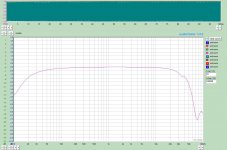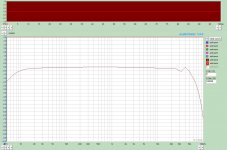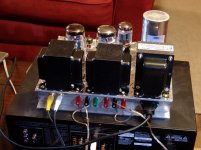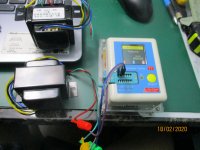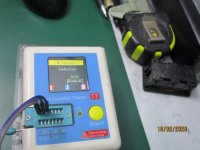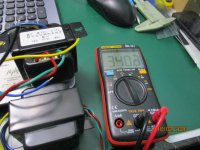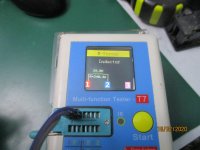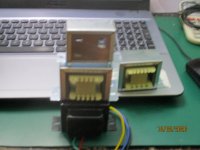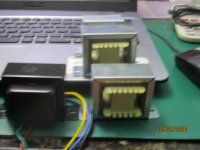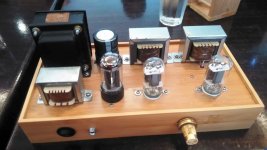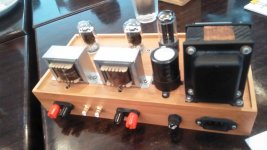I was able to dig up more specifications on the cheap Chinese ones that are currently on their way to me.
- Power: 8W (20Hz)
- Frequency response: 20Hz-40KHz, -3dB
- Primary: 5000Ω
- Secondary: 0-8Ω, or 0-4-8Ω
- Core size: EI66 stack thickness 35mm
- Dimensions: length 68MM + two fixed screws 30MM;width: 65MM;high 60MM
- Material: Japan imported z11 sheet
- Primary copper resistance: about 408Ω (B-P),
- Inductance: 38H
- Primary maximum allowable DC: 100mA
- Suitable for 6P14 (el34, el84, 6p3p)
- Weight : 1kg
Spec-wise they are nearly on-par with the Transcendar 7W 5kohm units. Perhaps it makes sense to take them more seriously than I have been.
>8 watts at 20hz? i highly doubt this...perhaps 8 watts at 1khz which is more tenable..
>- Primary copper resistance: about 408Ω (B-P),
- Inductance: 38H .....somewhat checked out...but varied depending on how they butt the E and I, the gaps....
>- Primary maximum allowable DC: 100mA ...again 408 ohms and 100mA is 40.8 volts, coil will dissipate 4 watts, i used 25mA in my opt..
I would ask Gerry at what frequency he rates his OTs. The "7W" transformer could be 7W at 40Hz.
5k Transcendar is decent OPT for not so high power amplifier, due to it's small core and a little high primary DCR.The Transcendars are getting more and more tempting.
Some years ago I built a 300B SE for my friend with 10W 5k Transcendar (43H, 380R DCR).
This amplifier (gyrator loaded C3g, capacitor coupling to FET source follower, direct drive fix biased 300B) has very likeable tone, but not so "thundering" bass, because OPT's higher copper loss and core's limited headroom at lower frequencies.
Attachments
Makes sense. Quality of wire would matter as well. I am more wondering how DCR affects overall amplifier performance. George has mentioned many times that certain OPTs are noticeably less efficient (by a watt or two) than others (all else being equal). I suspect DCR is a part of this but I am not knowledgeable enough to "know". 🙂
No, I was speaking about comparing one manufacturer/model to another. Your point here makes a lot of sense though.
in my build, i used #35 wire in the primary, #25 in the secondary,
2500 turns in the primary, 250 turns secondary,
the primary winding is split into two sections of 1250 turns each,
then the whole secondary coils, and then the other half of the primary winding.
winding order, 1/2P, S, 1/2P.......
scrambled winding on a nylon bobbin...
You can afford to buy expensive OPTs if you are willing to sell your 211 tubes or your 2A3 tubes.
Most of my 2A3'a and 211's are early vintage Chinese, not worth a whole lot. I have one used pair of RCA 2A3's, but they are the twin plate variety. I do have some used, but good vintage 211's and 845's which I suppose could fetch enough to pay for some pricey OPT's, but selling anything like that today is an invitation to get ripped off. I am still on the fence as to whether to rebuild my 845 SE amp or part it out. That depends on how the UNSET stuff plays out.
Would it be correct to assume lower primary DCR results in higher efficiency and less load/stress on the power tubes?
The DCR of an OPT is electrically equivalent to sticking an equal sized resistor in series with a perfect OPT's primary. It does, as stated result in lower DC voltage being applied to the output tube. This can be remedied by adding more voltage in the power supply. What is often overlooked is that resistor also sucks up some of your audio output power and turns it into heat. A 400 ohm DCR in a 5K opt will waste about 8% of your power, while a 100 ohm DCR will waste about 2%.
George has said that the Hammond is audibly better at bass than the EdCor CXSE-25-5K, which is 1/2 pound heavier than the Hammond and has a primary inductance of 50 H.
The Hammond is quite a bit bigger and heavier than the Edcor, although I don't have the exact specs handy. It has consistently produced bigger bass than the Edcor in several tests both electrical and listening, although the differences are small. In an amp like the UNSET where the tube presents a low dynamic impedance to the OPT, I actually prefer the sound of the Hammond since it doesn't roll off the highs. In a triode wired SSE with EL34's, I liked the Edcor better. NOTE that both my Hammonds and Edcors are 14 years old...I'm sure that the recipe has been changed since then....probably for cheapness sake. The Hammond costs considerably more than the Edcor in the USA. Not sure about Canada since shipping can be a big factor in an OPT, especially a big one.
My favorite SSE runs Transcendar OPT's that were designed for 300B's. I put my 8 ohm speakers on the 4 ohm tap to reflect a 6000 ohm load on the output tubes. I used EL34's in triode mode for most music on my Yamaha NS-10's.
When it's time to rattle the neighbors walls with some Pink Floyd, in go the KT88's with the current cranked up near 100 mA per tube, and the amp was connected to my 15 inch open baffle speakers which met the WAF by being concealed inside a matching pair of 1941 vintage Zenith console radios. I goth these OPT's about 15 years ago for $50 each so I bought 11 pair. If OPT's like these are still available, I would have no problem using them again. Now if they cost as much as an Edcor, it would depend on how much power I was going to squeeze through them.
The Transcendars in that SSE could make the walls vibrate in the house across the street through those speakers. With KT88's in UL with the CFB turned on. I got about 12 WPC in that amp with the 6000 ohm load, and about 16 WPC at 3000 ohms. To me the amp sounded better at 6000 ohms so that's where it stayed.
Sadly this amp was dropped when we were moving. It still works without it's motor run cap, but looks pretty ugly now.....again rebuild or part out?????
Attachments
- Primary: 5000Ω
- Inductance: 38H
- Frequency response: 20Hz-40KHz, -3dB
Those three specs don't seem likely to cohabitate inside the same transformer. The DCR specification makes me think that they may hit that inductance number, but then saying the TX is -3dB at 20Hz wouldn't make sense. Having that much copper and primary indcutance should also roll off the treble a little harder than it is IMO.
- Power: 8W (20Hz)
- Weight : 1kg
1kg is about half of what I would expect for such a transformer.
i agree with you, i built an opt of the same exact dimensions, and i called it 1 watt.....
i have the OPT's on hand and they are not 1kg each, maybe for the pair....
I would ask Gerry at what frequency he rates his OTs. The "7W" transformer could be 7W at 40Hz.
I'd like to know the answer too.
Gery only states frequency response at 1w, as stated earlier. The 7W 5K model:
- Frequency Response: 15 Hz to 75 kHz +/- 1 dB @ 1 Watt
This tells me nothing about the frequency response at 7W.
At least with Hammond, their frequency plots are at max rated power (even if they do look like crap, you know they will perform well at half power).
5k Transcendar is decent OPT for not so high power amplifier, due to it's small core and a little high primary DCR.
Some years ago I built a 300B SE for my friend with 10W 5k Transcendar (43H, 380R DCR).
This amplifier (gyrator loaded C3g, capacitor coupling to FET source follower, direct drive fix biased 300B) has very likeable tone, but not so "thundering" bass, because OPT's higher copper loss and core's limited headroom at lower frequencies.
What output power level was used for those plots?
What output power level was used for those plots?
Move the cursor over the plot.
The first is the amplifier at 10W, the second is only OPT measuring (Rgen: 700R, 1V RMS).
The Transcendars in that SSE could make the walls vibrate in the house across the street through those speakers. With KT88's in UL with the CFB turned on. I got about 12 WPC in that amp with the 6000 ohm load, and about 16 WPC at 3000 ohms. To me the amp sounded better at 6000 ohms so that's where it stayed.
Sadly this amp was dropped when we were moving. It still works without it's motor run cap, but looks pretty ugly now.....again rebuild or part out?????
One question George - how much do your Transcendars (designed for 300B) weigh?
(BTW excellent info as usual, thanks!)
Last edited:
I'd like to know the answer too.
Gery only states frequency response at 1w, as stated earlier. The 7W 5K model:
- Frequency Response: 15 Hz to 75 kHz +/- 1 dB @ 1 Watt
This tells me nothing about the frequency response at 7W.
At least with Hammond, their frequency plots are at max rated power (even if they do look like crap, you know they will perform well at half power).
i have the OPT's with me, that same ones coming your way...
i am not a bit worried that one measured 24H and the other 39H, they are all about the gapping...
Attachments
Move the cursor over the plot.
The first is the amplifier at 10W, the second is only OPT measuring (Rgen: 700R, 1V RMS).
Ah yes, I see that in the file name now.
This is extremely useful info to me. Thank you very much!
i have the OPT's with me, that same ones coming your way...
i am not a bit worried that one measured 24H and the other 39H, they are all about the gapping...
Those aren't the ones I bought. The ones I have coming are twice the size/weight, AFAIK.
This is extremely useful info to me.
THD (1kHz)
1W 1.57%
4W 3.09%
8W 4.69%
10W 4.97%
THD (1kHz)
1W 1.57%
4W 3.09%
8W 4.69%
10W 4.97%
Very nice.
I need to set myself up to do similar testing.
OPT must to be big, heavy, made with thin, qood quality laminations , with higher permeability, higher saturation.. wound with thick wire , means low resistance of the primary ..
then total loses can be expected cca 3-4% primary, 3-4%, sec. in total 7 ..to 8%.
opts which are smaller fisicaly, with big resistance of the primary have losses more than 15%? not good.
so good transformer must to have also some kilograms per watt..
but somewhere is a optimum because too big trafo isn't good too and has problems on the HF side..
then total loses can be expected cca 3-4% primary, 3-4%, sec. in total 7 ..to 8%.
opts which are smaller fisicaly, with big resistance of the primary have losses more than 15%? not good.
so good transformer must to have also some kilograms per watt..
but somewhere is a optimum because too big trafo isn't good too and has problems on the HF side..
Those aren't the ones I bought. The ones I have coming are twice the size/weight, AFAIK.
EI66 you posted is a 3/4 inch core, 66 being 66mm divided by 3 is 22 mm or 3/4 inches...that is the spec you posted..
i make my own traffos and uses the same material as your vendor from china, materials i used were imported from Taiwan...
there are two kits in the pictures, one is 5/8 and the other is 3/4...
Attachments
EI66 you posted is a 3/4 inch core, 66 being 66mm divided by 3 is 22 mm or 3/4 inches...that is the spec you posted..
i make my own traffos and uses the same material as your vendor from china, materials i used were imported from Taiwan...
there are two kits in the pictures, one is 5/8 and the other is 3/4...
The black ones you posted earlier look like they have a stack thickness of 25mm. I have seen those on ebay rated as 5 watt units and selling for $29 per pair.
The ones I bought have a stack thickness of 35mm (1.38 inches) and sell for $80 per pair, so they are not the same transformers, as far as I can tell.
The black ones you posted earlier look like they have a stack thickness of 25mm. I have seen those on ebay rated as 5 watt units and selling for $29 per pair.
The ones I bought have a stack thickness of 35mm (1.38 inches) and sell for $80 per pair, so they are not the same transformers, as far as I can tell.
good luck, we will know once and for all, EI66 is 3/4 inch and that was what they quoted from your post, i am not aware that 35mm bobbins for EI66 exist, let alone brackets....but there is only one way to find out, when you get the items...
i have asked my vendor for bobbins and brackets to find out...
- Home
- Amplifiers
- Tubes / Valves
- SE Output xfmrs....who are the current suppliers for not many $$$
